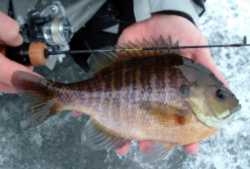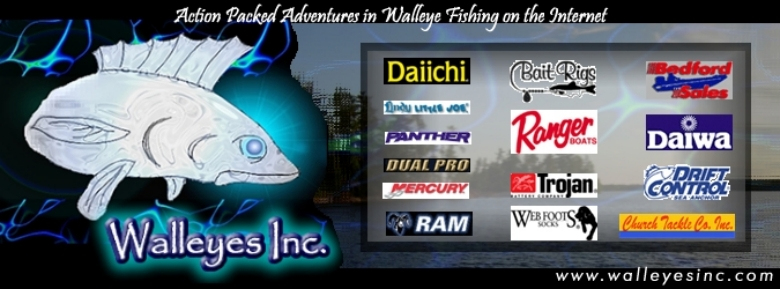The lesson was learned by accident… the result of trial
and error. Several years ago, a friend and I were fishing for
crappie on Jamestown Reservoir located in south central North
Dakota. In typical crappie fashion, most of the fish were suspended
about four feet off the bottom in twelve feet of water all morning
long. As the sun crept higher and the morning progressed, the
fish seemed to rise. By midday, the top half of the water column
came alive on the Vexilar with flashes of red and yellow indicating
suspended fish. The fish were eating anything that dropped in
front of them. Over the course of the day, the intensity dropped
and the action slowed. After trying to unsuccessfully get back
on the pod of fish by drilling more holes, we dropped back down
the original holes that had been so hot just hours before.
On a whim, I tried fishing really high, higher than the Vexilar
could read just inches below the ice. I had a fish on immediately.
When I set the hook, I thought I had snagged the bottom of the
hole. Up came a nice crappie and than another crappie. We were
into the fish again and the fish were literally inches below
our boots right under the ice. Pretty cool I thought. Perhaps
the zooplankton had collected right below the ice as the sun
increased in intensity or maybe something else happened relating
to the food chain that brought these fish continually higher
through out the day. These fish kept raising until the fish
were to the point of banging their heads on the bottom of the
ice.
 |
We have been able to stumble onto this pattern
with both sunfish and crappie. The fish keep rising following
clouds of scuds, backswimmers and other micro morsels
until they seemingly disappear. Disappearing in the sense
that electronics aren’t as effective. Even sight
fishing can be difficult because if the fish are running
right below the ice, using this massive plane as an edge
to corner and corral prey, we can only see an area the
size of the hole we drilled. |
There are other more dangerous situations however where this
pattern can emerge. Low oxygen levels, deep snow, dying vegetation
and the other biological factors that combine to form winter
fish kills. Obviously, life threatening oxygen depletion is
very stressful for a fish. When fish become too stressed, they
quit eating, game over. Until they hit this threshold however,
these stressed fish can be caught and usually, every fish in
the lake is just inches under the ice with their lips practically
licking the bottom of the ice because this is usually where
the last blanket of oxygen rich water can be found. This particular
pattern is a situation that I wouldn’t wish upon any of
your favorite panfish lakes but with this potential travesty
does come some window of opportunity.
Other situations where the six inches right below the ice is
worth fishing can sometimes occur in thick weed beds that are
basically unfishable. I just got off the phone with one of our
Pro Staff anglers and Ice Team Power Stick, Jim Hudson from
Bayfield Wisconsin. Jim is phenomenal ice angler who just works
hard at fishing and has a good understanding of how to crack
patterns. Jim is also a successful guide in Northern Wisconsin.
Hudson went on to describe a lake he had just fished in central
Minnesota for blue gill. They ended up finding many of their
fish right up along the shoreline in the midst of the thickest
and densest canopies of cabbage that they could find. The areas
they drilled were the spots on the ice where they could see
several weed fragments froze into the ice. The only way they
could even fish this jungle was by using the auger flighting
to actually ream out an area below the ice, chopping up weeds
and making a small window to snake an ice jig down. That is
where the fish were, right below the ice in weeds that were
virtually too thick to fish. Perhaps fish end up in locations
like this because of larger predators like pike or bass. Maybe
fishing pressure is factor in the sense that fish that spend
most of their time in these types of locations live long enough
to grow. The big blue gill that prefers the outside edge of
the weed bed located on a textbook break line has already been
caught by now on many lakes.
Day in and day out, the window of the water column that meets
the ice is not the first place we look for fish. But every now
and then, this edge where ice meets water has to be looked at
as we eliminate water and attempt to hunt for panfish. Most
anglers will fish the whole water column yet skip the zone right
below the ice. There are cases now and than where that may be
a mistake.
|

